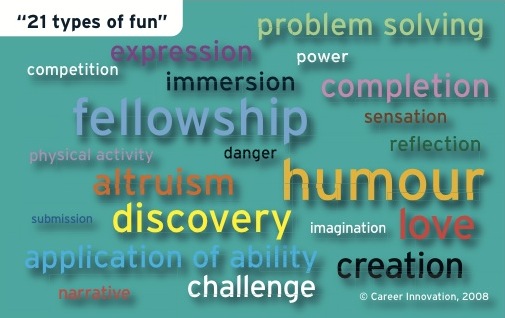Work can be fun. But until now there has been no systematic way to make it so. We analysed people’s motivation and built a taxonomy of 21 types of fun. It’s a new way to describe why people enjoy things they're not paid for, so fun can be designed into work.
The problem is, we don't have the tools and the language to redesign any kind of work and make it more energising.
All we have, at present, are some isolated case studies and examples. Most of those rely on competition as the central motivator. That's fine for competitive people (such as the male-dominated world of computer programming) but what about everyone else? How do we redesign work activities for people whose satisfaction comes from aesethetics, sociability or storytelling? Or how do we turn office drudgery into physical activity for the active, and into cafe conversations for the sociable?
To achieve this we need way to discover the many different kinds of satisfaction that matter most to people - the things that give them a buzz, a truly intrinsic reward - so that individuals, teams and organisations can re-design their work and take the 'work' out.
1. Analyse your motivation by thinking about fun non-work activities and ask: What energises me?
2. Invite your colleagues to do the same. (Notice: How does their fun profile differ from yours?)
3. Now analyse your work, or a particular item of work, using the same framework.
4. Based on the difference, it becomes obvious why the work is not as fun as it could be for everyone.
To do this systematically requires a taxonomy of fun - a set of core concepts that describe all the different ways that an activity can be immediately satisfying and energising. So that's where we (at R&D think-tank Ci) made a start, in partnership with AIESEC the world's largest student-led organisation.
|
|
21 Types of ‘Fun’ |
|
1 |
Fellowship |
|
2 |
Application of Ability |
|
3 |
Altruism |
|
4 |
Discovery |
|
5 |
Humour |
|
6 |
Problem-solving |
|
7 |
Completion |
|
8 |
Creation |
|
9 |
Challenge |
|
10 |
Power |
|
11 |
Love |
|
12 |
Immersion |
|
13 |
Expression |
|
14 |
Narrative |
|
15 |
Reflection |
|
16 |
Sensation |
|
17 |
Danger |
|
18 |
Competition |
|
19 |
Imagination |
|
20 |
Physical activity |
|
21 |
Submission |
- Higher engagement from people doing the work, leading to higher productivity and speed
- Reduction in work-related stress and increase in wellbeing by increasing "energising" activities
- More intelligent work design by spending time re-thinking what needs to be done and how
- More intelligent matching of people to work, through a systematic taxonomy of 'fun' motivational profiles
- Potential to lower wage costs by designing work that can be done by volunteers

It was very heartening to see this article. The only way of most effectively carrying out any work is by making it a fun. A great spiritual teacher once remarked that, "if a child were to be given a responsibility to play with a cat, it wouldnt be fun. he plays with it daily because it is fun." So too with us, whether it is at work place or our own life, to be happy we should be able to make our work a play or fun. Hope more managements and people realize this.
- Log in to post comments
- Log in to post comments





You need to register in order to submit a comment.